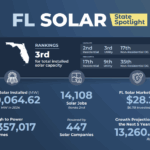
The decline of Net Energy Metering (NEM, also called Net Metering) policies through the United States has made many solar providers and homeowners look toward energy storage solutions, both partial and whole home.
Many utility companies have reduced or begun to reduce the amount of credit homeowners receive for power sent back to the grid, and batteries are becoming a requirement for homes who want to actually utilize all their solar energy.
NEM 3.0 was introduced in California in April of 2023 and since that time has had drastic consequences on the market. As reported by Ohm Analytics, California solar sales declined 77%-85% annually and widespread business closures have also plagued the market, leaving homeowners left wondering what to do.
Table of Contents
Approaching Solar After NEM Losses
Homeowners looking to go solar with reduced NEM rates often pursue one of a few avenues:
- Design their solar system to produce under 100% of their energy needs to minimize the power sent to the grid
- Load shift as much power consumption as possible to when the sun is out
- Add battery storage
Adding battery storage has rapidly become the preferred solution. Battery storage adoption rates are skyrocketing throughout the North American solar market, with the attachment rate at 25% in Q1 2024. As more and more people adopt batteries to replace lost NEM value, those homeowners are also learning about emergency backup potential.
It’s common to see “whole home backup” on battery manufacturer websites or in sales proposals, but is it possible and feasible?
Types of Backup
There are two common methods of connecting batteries to a home, “whole home” and “critical loads”.
Critical Loads
Backing up critical loads (breakers, appliances) is the most basic form of emergency backup and one of the most commonly practiced methods. Similar to how a homeowner might use a portable emergency generator, this style of connection involves separating out desired “critical loads” or those loads which are most important in a power outage.
Common examples of critical loads in a home are refrigerators, fans, sump pumps, well pumps, lights, and outlets where internet routers are plugged in.
Creating a critical load backup requires an electrician to put in a new, smaller electric panel (sub-panel) and move the chosen loads over.

When the power goes out, a home’s chosen battery/inverter control system will sever the connection between the main electric service panel and the new sub-panel to create a closed loop system and power the critical loads.
Pro’s
Ensures Power for Essential Needs:
- Critical load battery storage systems ensure that essential appliances and devices continue to operate during a power outage, which is particularly important for safety, health, and communication.
Cost-Effective:
- By focusing on critical loads rather than powering the entire home, the required battery capacity can be smaller, reducing the overall cost of the system compared to whole-home backup solutions.
Longer Backup Duration:
- Since the battery is only powering essential circuits, the stored energy can last longer during an outage, extending the time critical systems remain operational.
Less Strain on Battery:
- By only powering essential circuits, the battery experiences less strain, potentially leading to a longer lifespan for the system.
Con’s
Limited Coverage:
- Critical load systems do not provide power to the entire home, which can be inconvenient if the outage is prolonged or if non-critical circuits are later deemed necessary.
Complex Installation:
- Setting up a critical load battery storage system requires a certified electrician to install a sub-panel and carefully separate critical circuits, which can increase initial setup costs.
Potential for Misidentification:
- Homeowners may misidentify what is truly critical, leading to either inadequate backup coverage or unnecessary loads being included, which can shorten the available backup time.
Incompatible with Certain Appliances:
- Some high-demand appliances or systems (like HVAC units) might be considered essential but are often too power-hungry to be supported by a critical load system, requiring alternative solutions.
Whole Home
Whole home backup is a bit of a misnomer because it often refers to the style of connection rather than the output. The Whole Home Backstyle of connection where an electrician taps the inverter/battery control equipment into the utility lines from the meter to the main electric service panel. When the power goes out, power from the battery is able to feed anything in the home, as long as it doesn’t draw more than the battery can output.
So how does a home actually backup all their electric needs? In order to backup an entire home’s electric needs, additional batteries and/or inverters need to be added to increase capacity, this is typically referred to as battery stacking. To figure out what a battery is capable of doing, you’ll need to reference the data sheet and look for max continuous power.
The SolarEdge and Franklin batteries both have a max output power of 5 kW (kilowatts) and the Tesla Powerwall 3 has an output power of 11.4 kW.
The basic electric power formula is
Power = Volts * Amps (abbreviated P = IV)
Applying that to the batteries, we can say that at 5,000W max output a battery could power a 240V circuit of 20.8A, or a 120V circuit 41.6A. If you check any electric panel, you’ll see circuit breakers have numbers on the toggle switches representing its rated amperage. Conversely, you can also look up an individual appliance’s power rating for how many watts (W) or kilowatts (kW) it needs, then compare it to battery output.
If a home were to pull the full 5000W from a battery during an outage, one battery would drain in about 2 hours. Battery manufacturers estimate that when running just critical loads one battery will last 10-12 hours. By scaling up the batteries and inverters homeowners could run anything in the house in a down grid scenario – but it’s important to remember running many devices will drain the battery quickly.
Pro’s:
Comprehensive Coverage and Resilience:
- A whole home backup system ensures that all electrical devices and appliances can receive power during an outage, providing maximum convenience and comfort.
Simplifies Installation:
- Homeowners don’t need to decide which circuits are critical; the system automatically powers the entire home, eliminating the need for sub-panels.
Increased Flexibility:
- With power available to the entire home, homeowners can continue using high-energy appliances (e.g., HVAC systems, ovens, washers) during extended outages, as long as they have the battery capacity to support it.
Enhanced Property Value:
- Installing a whole home backup system can increase the value of a property, making it more attractive to potential buyers who prioritize energy security and self-sufficiency.
Cons:
High Initial Cost:
- If purchasing multiple batteries, whole home backup systems are more expensive to purchase and install compared to critical load systems.
Requires Large Battery Capacity:
- To power an entire home, the system needs substantial battery capacity, which can be both costly and space-intensive, potentially requiring multiple batteries.
Energy Management Challenges:
- Because anything in the home can be powered, if energy is not used judiciously batteries can drain quickly and leave homeowners compromised during extended outages.
Maintenance and Monitoring:
- Larger, more complex systems require regular maintenance and monitoring to ensure they function correctly, adding to the long-term costs and responsibilities for the homeowner.
Potential Overkill:
- In some cases, a whole home system might provide more backup power than needed, especially if the homeowner rarely experiences outages or can manage with a critical load system.
Choosing Between the Two
In the end, the feasibility of whole home backup comes down to a homeowner’s appetite for power and budget. If they’re willing to spend the money to achieve true whole home backup it is possible to do. If they only want one battery but want it to power anything in the home, the right expectations need to be set.
A trusted solar partner will walk their homeowner through all the options and considerations. Maybe you lose power often and work from home and you need the flexibility to use many devices/appliances. Maybe you don’t experience outages often and want a simple peace of mind install.
What we do know is that storage is the future of the solar industry as new NEM policies make their way through the solar market. As more storage is installed, it’s important to always protect it with high quality insurance-backed warranties for long term peace of mind.


